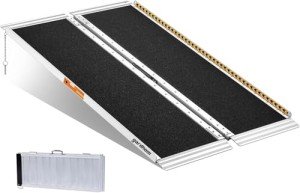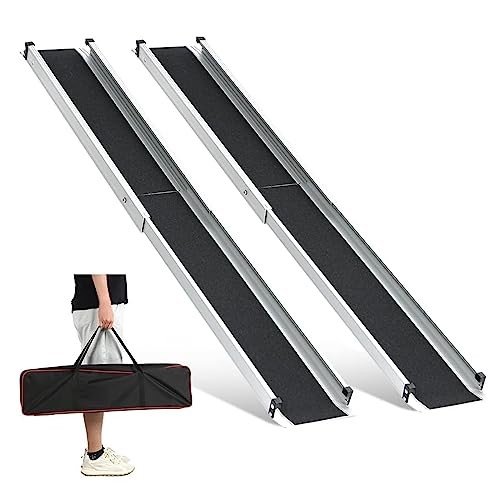
Ramps For Wheelchairs
Add a review FollowOverview
-
Founded Date November 9, 1915
-
Sectors Restaurant Food Services
-
Posted Jobs 0
-
Viewed 3
Company Description
10 Things People Hate About Wheelchair Ramps

Portable Wheelchair Ramps for Steps: A Comprehensive Guide
Browsing the world can be a difficulty for people with mobility issues, especially when coming across stairs. Standard stairs can present substantial barriers, but portable wheelchair ramps are a flexible and useful solution that can help people regain their independence and liberty. This blog site post uses an in-depth look at portable wheelchair ramps, including their types, benefits, considerations when choosing one, and answers to frequently asked concerns.
Understanding Portable Wheelchair Ramps
Portable wheelchair ramps are developed to provide a smooth shift from one level to another, such as from ground to a patio or in between floorings in a building. They can be easily transferred and established, making them perfect for temporary usage, travel, or in circumstances where a permanent ramp installation is not possible.
Kinds Of Portable Wheelchair Ramps
Before selecting a portable wheelchair ramp, it’s vital to comprehend the different types available on the market. The choice of ramp typically depends on specific needs, the environment, and the person’s mobility gadget. Below is a table laying out the most typical kinds of portable wheelchair ramps.
| Ramp Type | Description | Perfect Use Cases |
|---|---|---|
| Folding Ramps | Lightweight and foldable for simple transportation. | Home usage, travel, occasions |
| Telescoping Ramps | Adjustable length allowing personalization of the slope. | Differed heights, such as steps, curbs |
| Strong Ramps | Made from long lasting materials and supplies a steady entry. | Irreversible or semi-permanent setups |
| Luggage Ramps | Fold in half and look like a travel suitcase when closed. | Travel, outside events |
| Threshold Ramps | Little ramps designed to bridge the gap between different surfaces. | Doorways, transitions from surface areas |
Advantages of Portable Wheelchair Ramps
The availability of portable wheelchair ramps has actually changed how people with minimal mobility navigate environments. Below is a list of the various advantages connected with utilizing these ramps:
-
Accessibility: Ramps offer access to places with steps where wheelchair users would otherwise be not able to go.
-
Independence: With a portable ramp, users can go into and leave buildings and vehicles without external help.
-
Versatility: Ideal for various settings, including home environments, outside areas, and public places.
-
Alleviate of Use: Many ramps are lightweight and simple to set up, making them user-friendly for people and caregivers alike.
-
Cost-effectiveness: Portable ramps often come at a portion of the cost of long-term installations and can be recycled in various areas.
-
Safety: Ramps minimize the threat of falls and accidents connected with navigating up and down steps.
Factors to consider When Selecting a Portable Wheelchair Ramp
Choosing the ideal portable wheelchair ramp needs mindful consideration of several elements. Here are some bottom lines to remember:
-
Weight Capacity: Ensure that the ramp can support the weight of the wheelchair and its resident. A lot of ramps specify a maximum weight limitation.
-
Length and incline: A longer ramp offers a gentler slope, which is easier to browse. Ideally, the ramp length need to be 1:12 for ADA compliance, implying one inch of rise per foot of ramp.
-
Material: Ramps can be made from aluminum, fiberglass, or wood. Aluminum ramps are the most commonly used due to their light weight and toughness.
-
Portability: Look for ramps that can be easily folded or collapsed for transport.
-
Surface Texture: Ensures traction and avoids slipping, specifically in wet conditions. Gripped or textured surface areas are preferable.
-
Reduce of Setup: Consider ramps that do not require tools or complex assembly procedures.
Regularly Asked Questions (FAQ)
1. How do I figure out the right ramp length?
As a basic guideline, a ramp needs to have a slope ratio of 1:12. This means for every inch of height, you will need a minimum of 12 inches (or 1 foot) of ramp length.
2. Are portable wheelchair ramps ADA-compliant?
It depends upon the specific ramp design and dimensions. Constantly examine if the ramp satisfies the Americans with Disabilities Act (ADA) requirements, particularly for public usage.
3. Can I utilize a portable ramp outdoors?
Yes, numerous portable wheelchair ramps for steps (https://www.noahbostick.Top/) ramps are developed for outdoor usage and are made from weather-resistant products. Always inspect the specifications to validate.
4. How do I preserve a portable wheelchair ramp?
Keep the ramp tidy and inspect for damage frequently. Test the surface for wear and guarantee that it remains steady during usage.
5. Can wheelchair ramps be used for other mobility gadgets?
Yes, portable ramps can accommodate different mobility gadgets, including scooters, walkers, and power chairs.
6. Where can I purchase portable wheelchair ramps?
Portable wheelchair ramps can be bought from medical supply stores, online merchants, and specialized mobility devices suppliers.
Portable wheelchair ramps bridge the space between mobility difficulties and availability, allowing individuals with impairments to lead independent and satisfying lives. With a wide range of choices and a host of benefits, finding the best ramp needs thoughtful consideration of the user’s special needs. By understanding the advantages, features, and factors to think about, people and caretakers can make informed choices to improve mobility and availability. Whether for usage in your home, on the roadway, or in public spaces, portable wheelchair ramps are indispensable tools that open up the world to those who need them.


